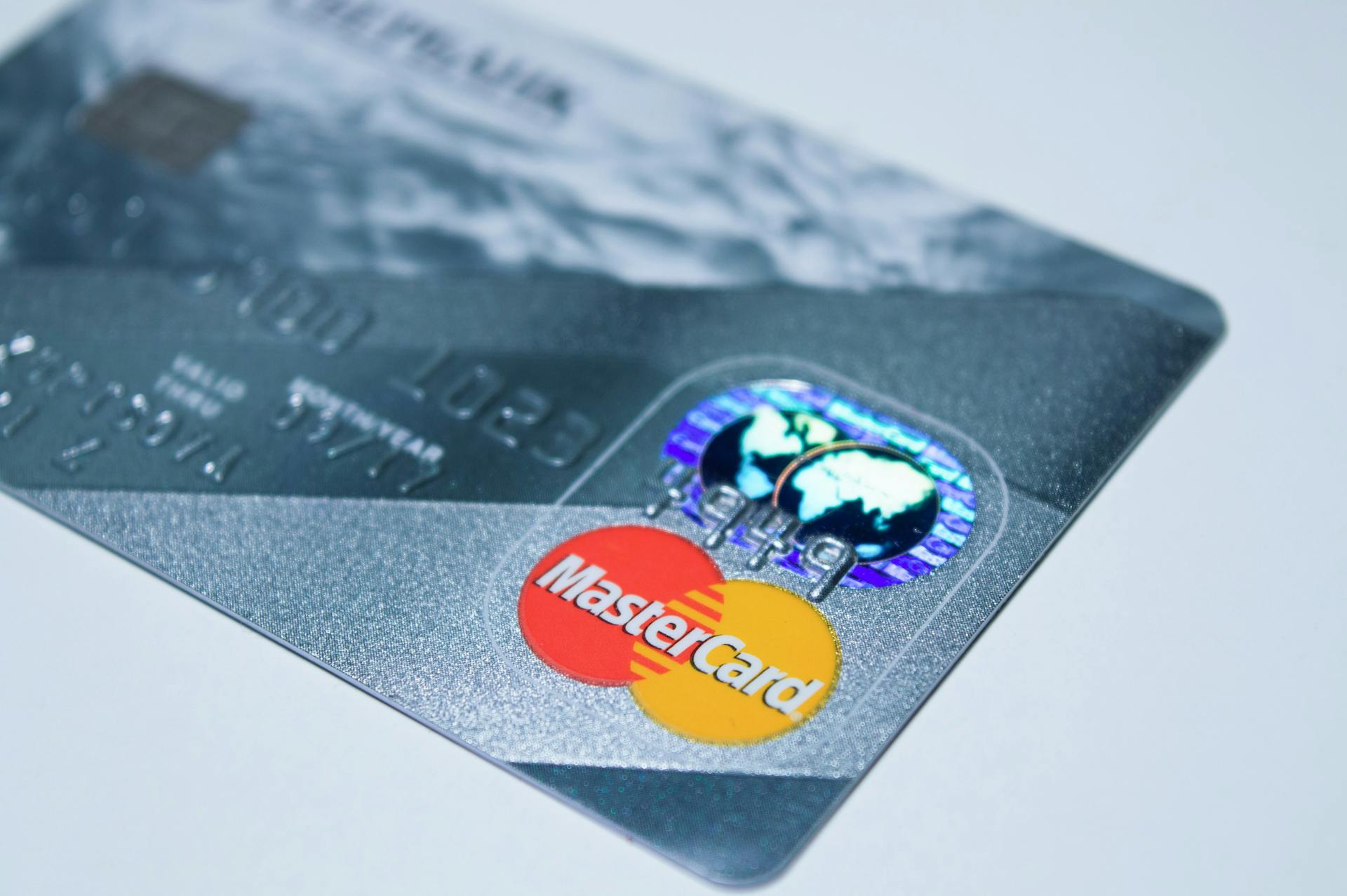
As you navigate the world of online payments, you might have come across the terms "acquiring bank" and "issuing bank." These two banks play distinct roles in the payment process, but their responsibilities are often misunderstood.
An acquiring bank is the bank that processes transactions on behalf of a merchant. It's essentially the bank that facilitates the transfer of funds from the customer's account to the merchant's account.
The acquiring bank is responsible for managing the risk of payment fraud and chargebacks, which can be a significant concern for merchants.
In contrast, the issuing bank is the bank that issues the customer's credit or debit card. It's the bank that provides the customer with the means to make a payment.
The issuing bank is responsible for verifying the customer's account balance and ensuring that the customer has sufficient funds to cover the payment.
Explore further: E S a Payments
What Is an Acquiring Bank?
An acquiring bank is a financial institution that manages merchant transactions made via card networks. They equip businesses with merchant accounts, which are essential for receiving funds from credit and debit payment card transactions.
Consider reading: Venmo Business Transactions
Acquiring banks generate revenue through fees charged to merchants and offer services for processing payments while managing risks related to merchant transactions, such as fraud and chargebacks. They play a crucial role in transaction processing, receiving transaction details, and routing them through the appropriate card networks.
Acquirers assume a significant amount of risk, particularly when it comes to security, and must adhere to the Payment Card Industry Data Security Standard (PCI DSS) to protect card information during and after a financial transaction. Failure to comply with these standards can expose the acquirer to significant liability.
Acquiring banks are responsible for managing the merchant's account, ensuring that funds from credit and debit card transactions are deposited correctly. They also represent the business in the transaction, ensuring that payments made by customers are processed and funds are deposited into the business’s account.
Acquirers are involved in the chargeback process, retrieving the funds from the business’s account and returning them to the issuer. This process can be costly for the acquirer, especially if the business contests the chargeback or if the chargeback volume is high.
Take a look at this: Are Money Orders Certified Funds
What Is a Bank?
A bank is a financial institution that provides various services to its customers, including issuing payment cards like credit and debit cards. Major issuers include well-known banks like Chase and Bank of America.
Issuers are responsible for issuing payment cards to consumers, giving them access to their funds or a line of credit. They also manage credit accounts, ensuring cardholders have access to their credit lines.
The issuer assumes the risk of extending credit to the consumer, evaluating their creditworthiness before issuing a card. This assessment considers credit score, financial history, and other relevant factors.
If a consumer defaults on their payments, the issuer bears the financial loss. They are also responsible for managing the credit accounts of cardholders.
A bank's role in the chargeback process is critical, as they review disputed transactions and determine their validity. If necessary, they initiate the process to return funds to the consumer.
Take a look at this: Swiss Bank Account Advantages
Acquiring vs Issuing Banks
An acquiring bank and an issuing bank are two distinct entities that work together to process credit or debit card payments online. They depend on each other, but they perform very different functions.
An acquiring bank is a bank or financial institution that processes card payments for businesses and ensures the funds from transactions are deposited into the merchant's account. They generate revenue through fees charged to merchants and offer services for processing payments while managing risks related to merchant transactions, such as fraud and chargebacks.
The acquiring bank represents the business in the transaction, ensuring that payments made by customers are processed and funds are deposited into the business's account. Merchant Account Services: The acquirer provides businesses with the ability to accept credit and debit card payments by setting up and maintaining merchant accounts.
The transaction process involves several key players, including the merchant, cardholder, acquiring bank, issuing bank, and credit card network. Here's a breakdown of each party's role:
- Merchant: The business accepting the payment
- Cardholder: The customer making the payment
- Acquiring Bank: The bank acting on behalf of the merchant
- Issuing Bank: The bank acting on behalf of the customer
- Credit Card Network: Visa, Mastercard, etc.
Both the acquiring bank and issuing bank serve essential roles in payment processing, and understanding their roles can help businesses negotiate better terms, reduce costs, and ensure smoother operations.
Payment Transaction Process
The payment transaction process is a complex series of steps that involves multiple parties, including the merchant, cardholder, acquiring bank, issuing bank, and credit card network.
The process starts with the merchant's payment processor sending the transaction details to the acquiring bank, which then routes it to the correct credit card network, such as Visa or Mastercard.
The acquiring bank forwards the transaction to the relevant card network, which sends an authorization request to the issuer, asking if the transaction can be approved based on the customer's available funds or credit.
The issuer reviews the transaction, checking the cardholder's account to ensure there are sufficient funds or available credit to cover the purchase. If approved, the issuer transfers the funds from the customer's account to the acquirer, who then deposits the funds into the merchant's account.
Here's a breakdown of the payment transaction flow:
- Step 1: Payment Initiation - The customer initiates a payment by swiping, tapping, or entering their card details at a point-of-sale terminal.
- Step 2: Authorization Request - The acquirer forwards the transaction to the relevant card network, which sends an authorization request to the issuer.
- Step 3: Approval or Decline - The issuer reviews the transaction and sends the decision back through the card network to the acquirer.
- Step 4: Settlement - If approved, the issuer transfers the funds from the customer's account to the acquirer, who then deposits the funds into the merchant's account.
In the event of a chargeback, the process is essentially reversed, with the customer initiating the chargeback with their issuer, who then investigates the claim and requests the return of funds from the acquirer.
Payment Processing Risks
Payment processing involves multiple steps and stakeholders, which can lead to various risks. One of the main roles in payment processing is the acquirer, which plays a crucial part in ensuring the transaction is legitimate and secure.
Card issuers also play a vital role in payment processing, but they don't directly interact with merchants during the transaction process. Both the acquirer and issuer serve essential roles in payment processing, as mentioned earlier.
Risks can arise when the acquirer or issuer fails to verify the cardholder's identity, resulting in unauthorized transactions. This can be a significant issue for businesses, as it can lead to financial losses and damage to their reputation.
The process of payment processing involves multiple stakeholders, including the card issuer, acquirer, and merchant. If any of these stakeholders fails to perform their duties, it can lead to payment processing risks.
Businesses can mitigate these risks by implementing robust security measures and verifying the cardholder's identity before processing a transaction. This can include using two-factor authentication and checking the cardholder's information against their account details.
Additional reading: Card Issuer vs Acquirer
Merchant Account and Authentication
Merchant accounts are provided by acquiring banks, which enable businesses to receive payments from customers. Acquiring banks decide whether a merchant account is low-risk or high-risk, affecting monthly interest fees, reserve funds, and holds.
High-risk accounts come with higher costs to protect the acquiring bank from irresponsible merchant management. This is a crucial aspect for businesses to consider when opening a merchant account.
The issuing bank plays a vital role in customer authentication and fund verification during transactions. They check for sufficient funds in the cardholder's account to complete the transaction.
Readers also liked: High Interest Savings Account Kansas City
Provides Merchant Accounts
A merchant account is a crucial tool for businesses to receive payments from customers. Acquiring banks provide these accounts, which enable businesses to accept payments.
To open a merchant account, a business submits an application to the acquiring bank. The acquiring bank then decides whether the account should be categorized as low-risk or high-risk.
High-risk accounts come with higher associated costs, as the acquiring bank wants to protect itself from potential losses. This includes higher monthly interest fees, reserve funds, and holds.
A merchant account is not the same as a personal bank account. It's specifically designed for businesses to receive payments, and it's secured through a separate agreement with the acquiring bank.
Related reading: University Credit Union High Yield Savings Account
Authentication
Authentication plays a crucial role in secure transactions. The issuing bank acts as a middle-man between cardholders and card networks, verifying customer authenticity and checking available funds.
During a card or online transaction, the issuing bank is responsible for customer authentication. This involves ensuring that the cardholder is who they claim to be.
Each transaction is usually sent by the issuing bank in a batch to a payment network. The payment network then directs the transactions to the appropriate recipients, such as the merchant.
The issuing bank is responsible for checking that there are sufficient funds available in the cardholder's bank account. This ensures that transactions can be completed successfully.
You might enjoy: Wave Free Version Auto Bank Transactions
Final Thoughts and Key Functions
The acquiring bank acts on behalf of the merchant during the payment process, ensuring the correct funds move to the correct accounts.
The issuing bank acts on behalf of the customer, protecting against fraud and mitigating the likelihood of chargebacks.
In the payment process, these banks work together seamlessly to prevent disputes and ensure a smooth transaction.
Acquiring banks ensure the merchant receives the correct funds, while issuing banks safeguard the customer's account from unauthorized transactions.
These key functions are crucial in maintaining trust and security in the payment process, making it a win-win for both the merchant and the customer.
Discover more: Capitalone Customer Service Hours
Sources
- https://paymentcloudinc.com/blog/acquiring-bank-vs-issuing-bank/
- https://www.tidalcommerce.com/learn/acquirer-vs-issuer
- https://monei.com/blog/acquiring-bank-vs-issuing-bank/
- https://www.nuvei.com/posts/acquiring-bank-vs-issuing-bank-whats-the-difference
- https://www.swipesum.com/insights/acquirer-vs-issuer-explained-what-they-do-and-how-they-work
Featured Images: pexels.com


